Damming the Amazon River
Air Date: Week of December 10, 2010
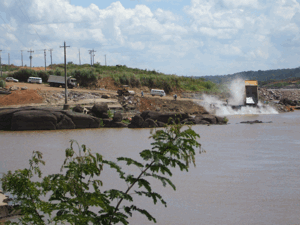 |
The Brazilian government is planning to build dozens of new hydroelectric dams in the Amazon river basin. It wants to develop the interior, and prevent power outages during the upcoming World Cup and the Olympics. Living on Earth's Bobby Bascomb visited a dam project on the Madeira River and reports on the environmental repercussions of hydropower in the Amazon.
Transcript
CURWOOD: Though droughts are becoming more frequent and intense in the Amazon, Brazil is going full steam ahead with plans to build hydroelectric dams throughout the region. Brazil’s economy is booming and energy planners want to prevent power outages like the one last fall that left nearly a third of the country without electricity. And they desperately need to keep the lights on when Brazil hosts the World Cup in 2014 and the Olympics 2 years later. Living on Earth’s Bobby Bascomb traveled to the Amazon –where one of the major hydro-projects is in the works and she has our report from the Madeira River.
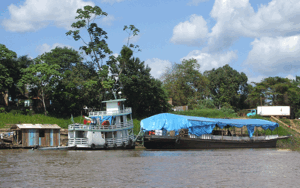
For $20 each, river boats like these carry passengers from Porto Velho to Manaus, a 4 day trip. (Photo: Bobby Bascomb)
[SFX SQUEAKING OF A PLANK, BOAT SOUNDS]
BASCOMB: From Porto Velho, in the Southwestern corner of the Amazon, the best--sometimes the only-- way to get around is by riverboat. A tree cut lengthwise serves as a squeaky foot-bridge between the shore and a floating dock on the Madeira River.
[SQUEAKING OF THE FOOT BRIDGE]
BASCOMB: Tied to the dock is a double-decker riverboat with peeling white paint and blue trim. A satellite dish sits on the roof, a group of men play pool…
[CLINK OF POOL BALLS]
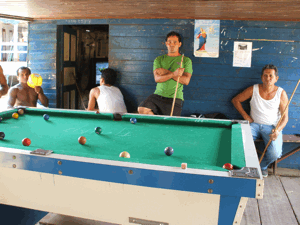
Playing pool on a river boat on the Madeira River (Photo: Bruce Gellerman)
BASCOMB: And, hammocks swing in the breeze.
[CARDOZO SPEAKING PORTUGUESE]
VOICE OVER: The first thing we do on the rivers of the Amazon here in Rondonia is ask permission to the river for us to navigate on it.
BASCOMB: Ivaneide Cardozo is petite, with long wavy black hair. Her father was a rubber tapper and she grew up in the forest with her family. Today she is head of Kaninde, an environmental NGO working to protect the Madeira River. She folds her hands together in prayer and speaks directly to the river.
[CARDOZO SPEAKING PORTUGUESE]
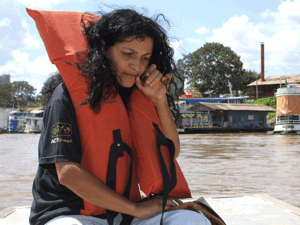
Ivaneide Cardozo is head of the environmental NGO, Kaninde. (Photo: Bruce Gellerman)
VOICE OVER: Rio Madeira, I want to ask you permission to come and do my work here and navigate on your waters. Thank you river.
CARDOZO: Obrigada Rio.
BASCOMB: Ivaneide leads the way across the riverboat to a small aluminum skiff tied up in the baking sun. We pull on bright orange life jackets and sit down carefully on the hot metal seats. Fish biologist Marco Lima is my translator in Brazil.
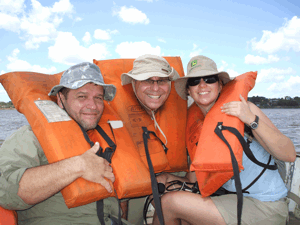
(Left to Right) Translator Marco Lima, LOE’s Bruce Gellerman and Bobby Bascomb head out on a boat to see the Santo Antonio dam under construction. (Photo: Bobby Bascomb)
LIMA: Sit down here, and I’ll sit in back.
BASCOMB: Okay.
LIMA: Watch out it’s really hot.
[SOUNDS OF MOTOR BOAT]
BASCOMB: We head up the largest tributary of the largest river in the world. The Madeira begins at the foot of the Andes Mountains in Bolivia and flows northwest to join the Amazon 2,000 miles away.
[SOUNDS OF MOTOR, WAVES]
BASCOMB: Madeira means wood in Portuguese, and we watch huge tree trunks float by. During the rainy season the river flows so fast that it erodes the banks and pulls giant rainforest trees out by their roots. The biodiversity of the Madeira River is legendary-- more than 800 species of birds, 33 species of mammals, and 750 species of fish: giant catfish and piranha, fresh water saw fish with long- toothed- bills. Ivaneide Cardozo scans the water and sees something exciting.
[COMMOTION IN THE BOAT IN PORTUGUESE]
LIMA: A big red dolphin! A pink dolphin!
[CARDOZO SPEAKING IN PORTUGUESE]
LIMA: Look over there. There is a bunch of dolphins.
BASCOMB: Like many of the species here, the endangered pink river dolphin is only found in the Amazon. Five miles up river we have gone as far as we are permitted. Marco ties the skiff to a log at the bottom of the riverbank. Just ahead big pick up trucks dump load after load of giant rocks into the river, the foundation of the Santo Antonio Dam.

Trucks dump loads of rocks into the Madeira River to form the Santo Antonio Dam. (Photo: Bruce Gellerman)
LIMA: As you can see, what they are starting to do here is that they are simply starting the damming of the whole Wood River.
[SOUNDS OF RUBBLE POURING INTO RIVER]
BASCOMB: Seven miles up river another dam, the Jirau, is quickly growing as well. Together the two dams should produce over 6,400 megawatts of electricity, roughly enough energy for all the homes in a city the size of Boston. The government created several short films to sell the dams to the public.
[SOUND OF GOVERNMENT FILM REGARDING THE DAMS IN PORTUGUESE]
VOICE OVER: The Santo Antonio and the Jirau dams on the Madeira River are important parts of the national effort to produce more energy so the country grows.
[SOUND OF GOVERNMENT FILM REGARDING THE DAMS IN PORTUGUESE]
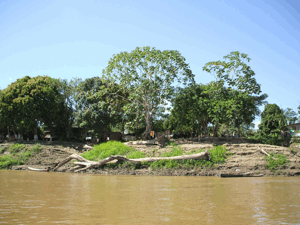
Rushing water from the Madeira River can pull rainforest trees out by their roots. (Photo: Bobby Bascomb)
VOICE OVER: We need more energy for industry, agriculture, houses and schools. We cannot develop without energy.
BASCOMB: About 80 percent of Brazil’s electricity comes from hydropower. So Brazil has a lot of experience with building dams, though not always successfully. Twenty-five years ago the Balbina dam, to power the city of Manaus, flooded nearly 1000 square miles of rainforest.
The decaying vegetation there produced massive amounts of the powerful greenhouse gas methane, yet the dam generated only 112 megawatts of electricity. That would power 33,000 U.S. homes. But Santo Antonio Energia says the Santo Antonio dam will be different. Ricardo Ovis is the sustainability manager.
[OVIS SPEAKING PORTUGUESE]
VOICE OVER: Of all the hydro plants in Brazil this will have the least impact. For six years we’ve had consultants coming from several institutions in Brazil. They told us what we needed to do to minimize the possible future impacts.
BASCOMB: Yet Ivaneide Cardozo remains skeptical.

Ivaneide Cardozo (center) with two Kaninde workers points towards where the Santo Antonio dam will be. (Photo: Bruce Gellerman)
[CARDOZO SPEAKING PORTUGUESE]
VOICE OVER: What we want is development, yes, but development that respects the people, human rights, and the environment. With this dam there will be incredible deforestation and such a big impact on the indigenous people and riverine people who live along the river.
BASCOMB: Many people living along the river depend on it for their food.
FEARNSIDE: It’s one of the rivers in the Amazon that has the most fish.
BASCOMB: Phillip Fearnside is an ecologist with INPA, the Brazilian National Institute for Research in the Amazon. He’s tall, lanky, and has a thick gray mustache that covers his entire mouth.
FEARNSIDE: It supplies the baby fish for the whole system. That’s important for the fish that breed in the headwaters of the Madeira and then go down stream into the main part of the Amazon and grow to their huge size.
BASCOMB: The giant Amazonian catfish can grow up to nine feet long and 600 pounds. They are literally man-eaters, infamous for tearing legs and arms off SCUBA divers and swimmers. From the mouth of the Amazon at the Atlantic Ocean, adult catfish swim the length of the Maderia to the Andes Mountains to breed. It’s 3,000 miles against the current.
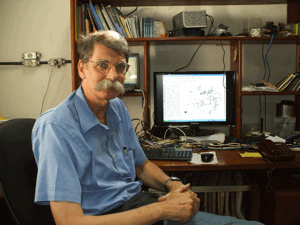
Amazon research scientist Phillip Fearnside. (Photo: Bobby Bascomb)
The developers plan to build channels around the dams for catfish and other migratory species to pass through.
FEARNSIDE: Nobody knows if that will work or not.
BASCOMB: Again, Phillip Fearnside.
FEARNSIDE: No one’s done it with these catfish before. It’s not like salmon or trout or something that people have a lot of experience with.
BASCOMB: Unlike salmon or trout, catfish are bottom dwellers. And scientists just don’t know how they will navigate through a fish channel.
FEARNSIDE: So, it’s likely that they won’t make it past these barriers. But even if they do make it to Peru and Bolivia and breed, the larvae fish come floating down the river - when they get to the turbines they’ll be sucked through the turbines because they won’t be swimming around the edge to these side channels.

In the Amazon 98 percent of the fish sold in markets are migratory. Scientists and local communities are concerned about the future of the fisheries once a dam is in place. (Photo: Bobby Bascomb)
BASCOMB: Another danger for any fish that do survive is mercury poisoning. Thirty years ago the Madeira River basin was brimming with gold miners. They used mercury to separate out the gold and threw the waste into the river. Mercury settles to the bottom unless rushing water from a dam churns it up.
Researchers already see elevated levels of mercury in many communities that depend on river fish for food. A World Wildlife Fund video titled “The Madeira River: Life Before the Dams” documents the lives of indigenous tribes like the Parintintin who live along the river.
CLICK HERE FOR THE WORLD WILDLIFE VIDEO, "LIFE BEFORE THE DAMS"
[PARINTINTIN MAN SPEAKING PORTUGUESE]
VOICE OVER: Today the supermarket for the Indians is the river. The non-Indians in the city goes to the market to buy a kilo of beef or fish. And when they build this dam what happens to the culture of the Indian whose livelihood is fishing? Is somebody going to bring food here? No, nobody will.
BASCOMB: A hundred miles upstream from the Santo Antonio dam is the non- indigenous community of Mutumparana. The supermarket is in the center of town, where several dirt roads meet.
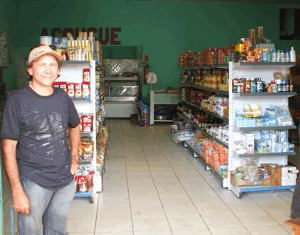
The supermarket in Muntumparana. (Photo: Bobby Bascomb)
[SOUNDS FROM SHOPPING MARKET]
BASCOMB: Shoppers bustle in and out buying fruit juice, pasta and vegetables. Jose Fidehamaya has owned this store for 32 years. When the dam is finished the village will disappear under water and Fidehamaya and his customers will move to a new town the government is building for them.
[FIDEHAMAYA SPEAKING PORTUGUESE]
VOICE OVER: My expectation is to be really cool, because we are expecting to move for better.
BASCOMB: Jose bags a few canned goods for Fransica, a regular customer. He uses a calculator to figure out her total, then flips through a spiral bound note book to find her name.
[SOUND OF PAGE TURNING]
[FIDEHAMAYA SPEAKING PORTUGUESE]
VOICE OVER: Well let me tell you the way I do. I simply buy and what ever the people can pay me they pay and what ever they can’t pay they pay at the end of the month, when they receive their salaries.
BASCOMB: So, will you take that same business model with you to the new community?
[FIDEHAMAYA SPEAKING PORTUGUESE]
VOICE OVER: Oh, no! Over there I’m going to use a computer. I’m going to finish, terminate this book right here.
BASCOMB: His customer, Fransisca, says she’s also looking forward to the move.
[FRANSISCA SPEAKING PORTUGUESE]
VOICE OVER: For me, I think it will be better. Life here is not easy. This area has a lot of malaria. We suffer a lot in this place. I’m not going to miss it.
BASCOMB: But not everyone in Mutumparana is eager to pack their bags.

A home in the village of Mutumparana (Photo: Bobby Bascomb)
[DOG BARKS]
BASCOMB: Maria Jose sits on the back porch with her dog facing the garden. Inside her children watch a TV game show.
[MARIA JOSE SPEAKING PORTUGUESE]
VOICE OVER: This place is so peaceful by the river. I have a lot of memories from this place. But we have to leave. We are obligated.
BASCOMB: The outgoing president of Brazil, Luiz Inacio Lula de Silva has an 80 percent approval rating. He’s made development, jobs, and dam construction the hallmarks of his administration.
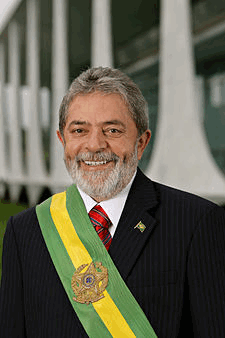
Outgoing president of Brazil Luiz Inacio Lula De Silva. (Wiki Commons)
[LULA SPEAKING PORTUGUESE]
VOICE OVER: We are building a hydroelectric dam that is a model for the world and we will continue building. Our most important concern is the Brazilian people.
BASCOMB: Brazilians love Lula but many observers see a conflict of interest. Brazil’s largest construction company, Odebrecht, is pouring the concrete on the Madeira River. The company also poured a lot of money into President Lula’s campaign fund.
Lula’s hand picked successor, Dilma Rousseff, shares Lula’s ambitions for Brazil. She recently won the presidential election but earlier in her career she was head of the agency that approved projects like the Madeira River dams.

Dilma Rousseff, President Elect of Brazil. (Photo: Wiki Commons)
[ROUSSEFF SPEAKING PORTUGUESE]
VOICE OVER: It’s necessary to realize our potential. If we think of our country as small it will stay small. Or we can think big, for example the hydroelectric dams.
BASCOMB: At first IBAMA- Brazil’s version of the EPA- denied approval for the dams, saying the environmental review was inadequate. Lula’s government ordered IBAMA to approve the dams anyway.
The director of the agency at the time was forced to resign and a few months later IBAMA gave the green light, stipulating 33 changes to mitigate environmental damage. Cesar Guimares is chief of IBAMA in the state of Rondonia, where the Madeira River dams are being built.
[GUIMARES SPEAKING PORTUGUESE]
VOICE OVER: Political pressures will always exist but we need to remember that we need a clean environment to live well.
BASCOMB: I’m wondering if you ever feel threatened to do what people want you to do in terms of approving the dam project.
[GUIMARES SPEAKING PORTUGUESE]
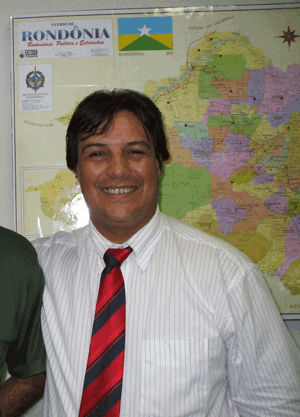
Cesar Guimares is the chief of IBAMA, Brazil’s environmental law enforcement agency in Rhondonia. (Photo: Bobby Bascomb)
VOICE OVER: I love my job but this threat is not only to me, but to other agents and the institution. But it is my duty.
BASCOMB: After we stopped recording Guimaraes’ cell phone rang. He didn’t answer it. He says he often doesn’t answer his phone because it could be a death threat. His job- enforcing environmental law busting illegal loggers and poachers - makes him unpopular. Many in the scientific community say the environmental impact statement IBAMA finally signed off on is still inadequate. Research scientist, Philip Fearnside.
FEARNSIDE: The environmental impact process had virtually no affect on the actual decision of whether they were going to make the dam or not. They already decided to make it before they had information about what the impact would be and the reports themselves don’t cover the impact very well.
BASCOMB: Fearnside says the environmental review only examined impacts upstream of the dams and stopped at the Bolivian border. It didn’t consider floods on the Bolivian side of the river, the methane the dam would create, or how ecosystems and communities down stream will be affected. And, Fearniside says the government sold the dams to the Brazilian people under false pretenses.
FEARNSIDE: One gets the impression this electricity is going to be lighting the light bulb in your house, and your television and so forth, and that’s really a very small part of it. A lot of this electricity is going for making aluminum, for example, that’s exported to the rest of the world.
BASCOMB: A Brazilian smelter can use as much energy as a city of a million people. In the end, Fearnside says the benefits might not outweigh the costs.
FEARNSIDE: No body has counted up all these impacts of these dams that are destroying the fisheries, emitting greenhouse gases. All these things, you have to add all these things up and compare them with what Brazil is getting in benefits.
BASCOMB: The Madeira River dams are just two of 60 such projects planned for the Brazilian Amazon, part of a huge international development to connect the countries of South America with paved roads and waterways so export goods like soy can be transported to the coasts more cheaply.
[WATER SOUNDS, CONSTRUCTION SOUNDS]
BASCOMB: Back in Rondonia the Madeira River continues to flow freely to the Atlantic Ocean, just as it has since the Andes Mountains rose up ten million years ago. But not for much longer. Construction of the Jirau and Santo Antonio dams continues around the clock and they’ll both be finished within two years.
[SOUNDS OF DAM CONSTRUCTION]
BASCOMB: For Living On Earth I’m Bobby Bascomb in Porto Velho, Brazil.
Links
INPA- Brazilian National Institute for Research in the Amazon
Living on Earth wants to hear from you!
Living on Earth
62 Calef Highway, Suite 212
Lee, NH 03861
Telephone: 617-287-4121
E-mail: comments@loe.org
Newsletter [Click here]
Donate to Living on Earth!
Living on Earth is an independent media program and relies entirely on contributions from listeners and institutions supporting public service. Please donate now to preserve an independent environmental voice.
NewsletterLiving on Earth offers a weekly delivery of the show's rundown to your mailbox. Sign up for our newsletter today!
 Sailors For The Sea: Be the change you want to sea.
Sailors For The Sea: Be the change you want to sea.
 The Grantham Foundation for the Protection of the Environment: Committed to protecting and improving the health of the global environment.
The Grantham Foundation for the Protection of the Environment: Committed to protecting and improving the health of the global environment.
 Contribute to Living on Earth and receive, as our gift to you, an archival print of one of Mark Seth Lender's extraordinary wildlife photographs. Follow the link to see Mark's current collection of photographs.
Contribute to Living on Earth and receive, as our gift to you, an archival print of one of Mark Seth Lender's extraordinary wildlife photographs. Follow the link to see Mark's current collection of photographs.
 Buy a signed copy of Mark Seth Lender's book Smeagull the Seagull & support Living on Earth
Buy a signed copy of Mark Seth Lender's book Smeagull the Seagull & support Living on Earth

